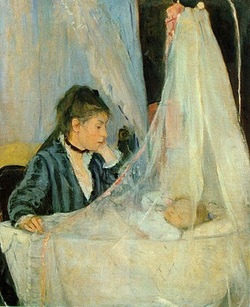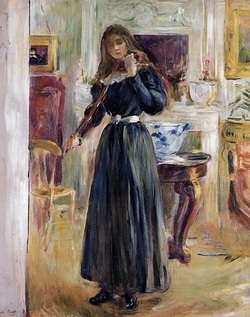Berthe Morisot (1841-1895)
In 1855, Madame Morisot, Berthe's mother, made arrangements so her three daughters could take art lessons with Geoffrey-Alphonse Chocarne. Not much time passed before the Morisots replaced Chocarne with Joseph Guichard. Berthe also received informal training in plen-air painting from Camille Corot. Much of Morisot's works reflect the warm tonalities of Corot's paintings. In 1864, a studio was built for Morisot and her sister, Edma. Morisot exhibited at the Salon that year and continued to do so throughout the 1860's.
During the Franco-Prussian War, Morisot stayed in Passy. After France surrendered, she left for the city slightly west of Paris, St. Germain-en-Laye. Morisot married Impressionist artist Manet's younger brother, Eugene, in 1874. In the same year, she participated in the first Impressionist exhibition. This action made her the only female founding member of the group.
Berthe Morisot took part in the third Impressionist exhibition in 1877, but not the fourth because she had a baby, Julie, in 1878. Morisot participated in the Impressionist exhibitions of 1880, 1881, 1882, and 1886. Her daughter, Julie, became her favorite model during the early 1880's. The Craddle, one of Morisot's most famous paintings, depicts her sister gazing at her new born daughter. In most of Morisot's paintings, she depicted the lifestyle, clothing, relationships, and surroundings of the bourgeoisie. In her painting Julie au Violon, Morisot shows her daughter playing the violin.
After Berthe married Eugene, Impressionism artist Renoir along with Degas and Monet were often entertained at her husband's home during the 1880's. Morisot sent some of her work to Les XX, an invitational exhibition, in Febraury of 1887. Her Impressionist was introduced to America later that year when Paul Durand-Ruel exhibited her paintings along with others in his New York Gallery.
During the Franco-Prussian War, Morisot stayed in Passy. After France surrendered, she left for the city slightly west of Paris, St. Germain-en-Laye. Morisot married Impressionist artist Manet's younger brother, Eugene, in 1874. In the same year, she participated in the first Impressionist exhibition. This action made her the only female founding member of the group.
Berthe Morisot took part in the third Impressionist exhibition in 1877, but not the fourth because she had a baby, Julie, in 1878. Morisot participated in the Impressionist exhibitions of 1880, 1881, 1882, and 1886. Her daughter, Julie, became her favorite model during the early 1880's. The Craddle, one of Morisot's most famous paintings, depicts her sister gazing at her new born daughter. In most of Morisot's paintings, she depicted the lifestyle, clothing, relationships, and surroundings of the bourgeoisie. In her painting Julie au Violon, Morisot shows her daughter playing the violin.
After Berthe married Eugene, Impressionism artist Renoir along with Degas and Monet were often entertained at her husband's home during the 1880's. Morisot sent some of her work to Les XX, an invitational exhibition, in Febraury of 1887. Her Impressionist was introduced to America later that year when Paul Durand-Ruel exhibited her paintings along with others in his New York Gallery.


